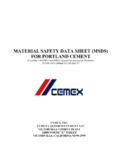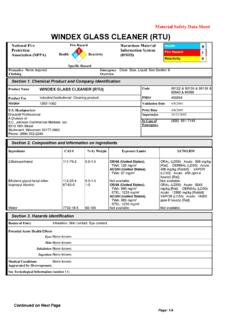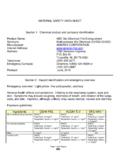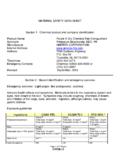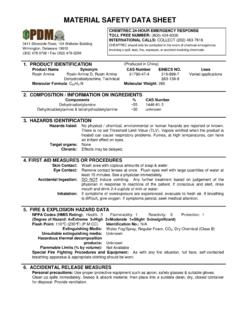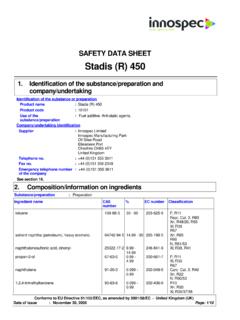Transcription of Material Safety Data Sheet HYDROGEN SULFIDE
1 HYDROGEN SulfidePage 1 of 6 Safety Data SheetHYDROGEN SULFIDEA ugust 31, 1995 PHONE NUMBERSPHILLIPS 66 COMPANY Emergency: (918) 661-8118A Division of Phillips Petroleum Company General msds Information:Bartlesville, Oklahoma 74004 (918) 661-8327 For Additional MSDSs: (918) 661-5952A. Product Identification Synonyms: Sulfuretted HYDROGEN ; Hepatic Gas; Hydrosulfuric Acid Chemical Name: HYDROGEN SULFIDE Chemical Family: Inorganic Acid Chemical Formula: H2S CAS Reg.
2 No.: 7783-06-4 Product No.: Not Established Product and/or Components Entered on EPA's TSCA Inventory: YES This product is in commerce, and is listed in the Toxic SubstancesControl Act (TSCA) Inventory of Chemicals; hence, it may be subject toapplicable TSCA provisions and Hazardous Components CAS % OSHA ACGIH Ingredients Number By Wt. PEL TLV HYDROGEN SULFIDE 7783-06-4 100 10 ppm 10 ppm@ @ Short term exposure limit is 15 Personal Protection Information Ventilation: Use adequate ventilation to control exposure below recommended levels.
3 Respiratory Protection: For concentrations exceeding the recommended exposure level, use NIOSH/MSHA approved air purifying respirator. If conditions immediately dangerous to life or health (IDLH) exist, use NIOSH/MSHA approved self-contained breathing apparatus (SCBA) equipment. Eye Protection: For splash protection use chemical goggles and face shield. Skin Protection: Gloves and coveralls of rubber or neoprene construction if liquid contact could occur. AvoidHydrogen SulfidePage 2 of 6 unnecessary skin contamination with Material .
4 NOTE: Personal protection information shown in Section C is based upon general information as to normal uses and conditions. Where special or unusual uses or conditions exist, it is suggested that the expert assistance of an industrial hygienist or other qualified professional be Handling and Storage Precautions Proper personal protective equipment must be used when handling this chemical. Do not get liquefied gas into eyes, on skin, or on clothing. May cause freeze burns upon direct contact. Do not breathe vapor, mist, fume or dust. May be harmful. Launder contaminated clothing before reuse. Use only with adequate ventilation.
5 Wash thoroughly after handling. Keep away from heat, sparks, and flames. Secure container to prevent damage. Store in a well-ventilated area. Store in tightly closed container. Bond and ground during transfer. Do not puncture or incinerate container. Handle cylinders with care. Protect cylinders from physical damage. Containers should not be subjected to temperatures above 125F. Do not heat cylinders by any means to increase the product discharge rate. Use a check valve or trap in the discharge line to prevent backflows into the cylinders. All electrical equipment should be non-sparking or explosion proof.
6 Test atmosphere periodically for H2S. Do not rely on sense of smell for H2S release. Use product in a closed Reactivity Data Stability: Stable Conditions to Avoid: Heat, flame, or other sources of (Materials to Avoid): Concentrated nitric acid, sulfuric acid, and other strong oxidizers. Vapors will combust spontaneously when mixed with chlorine, nitrogen trifluoride, or oxygen trifluoride vapors.
7 Distinct HYDROGEN SULFIDE odor can be masked by high concentrations of vapors or gas of other chemicals. Hazardous Polymerization: Will Not Occur Conditions to Avoid: Not Applicable Hazardous Decomposition Products: Sulfur Oxides formed when Health Hazard DataRecommended Exposure Limits: See Section Effects of Overexposure: Eye: May be irritating to eyes at levels near the permissible exposure limit. Liquid may cause freeze burns. HYDROGEN SulfidePage 3 of 6 Skin: Gas not expected to be irritating to skin. Liquid may cause freeze burns, irritation, reddening or swelling.
8 Inhalation: Toxic by inhalation. Release of liquefied product may create atmospheres which can rapidly exceed lethal levels. Acute low level exposure that exceeds the permissible exposure limit will result in irritation of the nose and throat, headache, dizziness, nausea, and nervousness. Ingestion: Liquid may cause freeze burns and and Chronic Effects of Overexposure: Humans breathing up to 8 ppm of HYDROGEN SULFIDE over a two month period experienced nausea, headache, shortness of breath, sleep disturbance, eye and throat Health Effects: The odor of HYDROGEN SULFIDE may not be recognized after prolonged inhalation due to paralysis of the sense of smell.
9 Effects from inhaling the fumes may lead to chronic bronchitis, respiratory irritation, increased loss of pulmonary function, and tearing of the Hazard Categories: Animal Human Animal Human Known Carcinogen ___ ___ Toxic _X_ _X_Suspect Carcinogen ___ ___ Corrosive ___ ___Mutagen ___ ___ Irritant ___ ___Teratogen ___ ___ Target Organ Toxin _X_ _X_Allergic Sensitizer ___ ___ Specify - Skin & Eye Hazard - Freeze burns;Highly Toxic ___ ___ Lung Hazard-Irritant; Nerve ToxinFirst Aid and Emergency Procedures:NOTE: For freeze burns, immediately flush effected area with tap water for at least fifteen minutes, seek immediate medical attention.
10 Eye: Flush eyes with running water for at least fifteen minutes. If irritation or adverse symptoms develop, seek medical attention. Skin: Wash skin with soap and water for at least fifteen minutes. If irritation or adverse symptoms develop, seek medical attention. Inhalation: Immediately remove from exposure. If breathing is difficult, give oxygen. If breathing ceases, administer artificial respiration followed by oxygen. Seek immediate medical attention. Ingestion: If illness or adverse symptoms develop, seek medical attention. Prompt medical attention is mandatory in all cases of overexposure to HYDROGEN SULFIDE .
